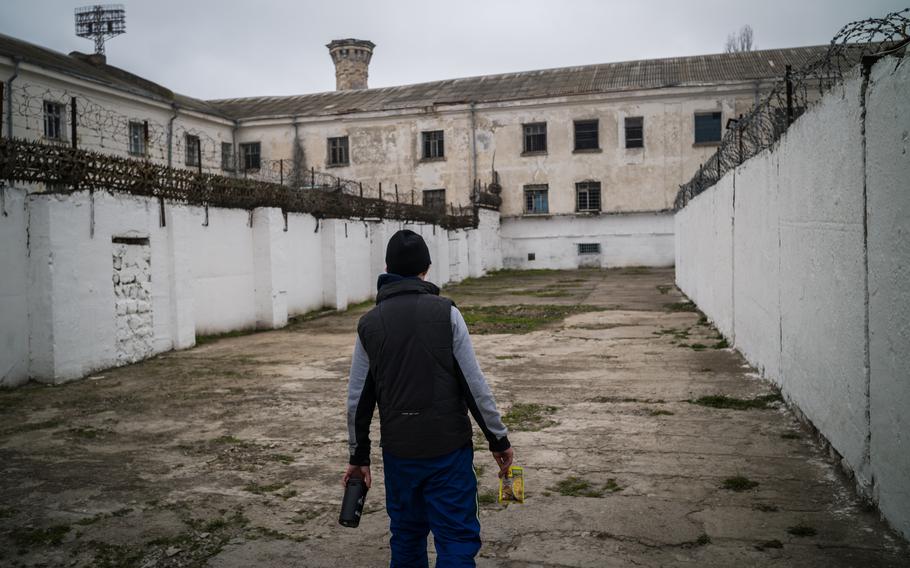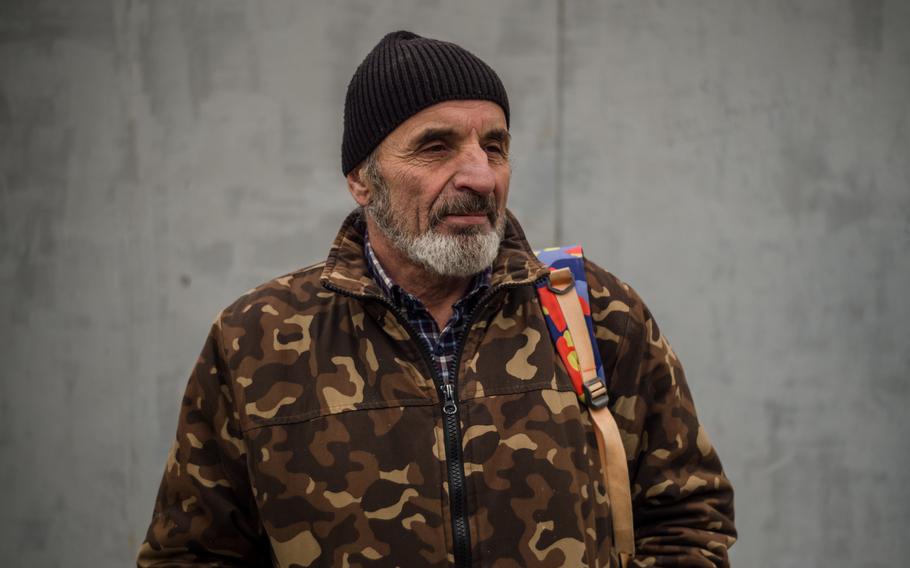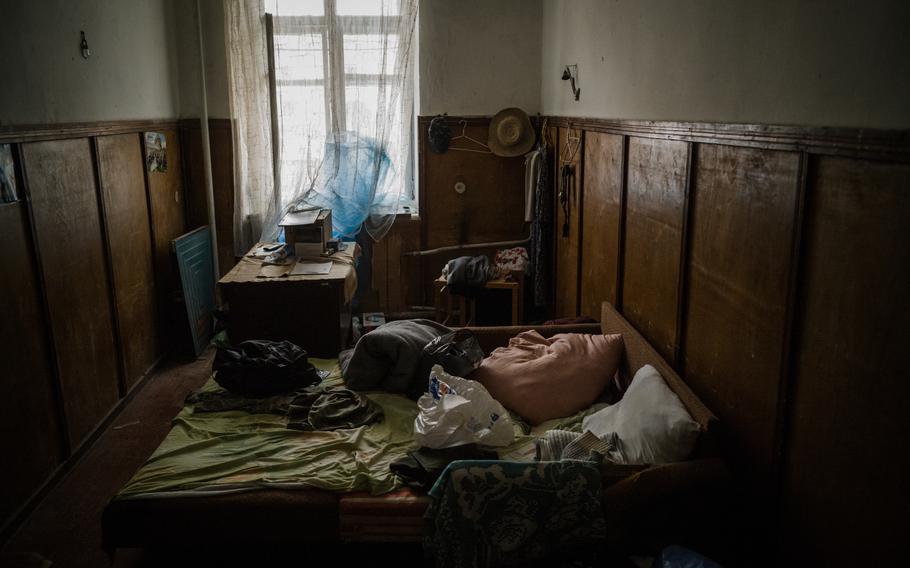Europe
Witnesses recount detentions, torture, disappearances in occupied Kherson
The Washington Post November 15, 2022

A man walks Sunday in the yard of a prison in Kherson, Ukraine, where he said Russian jailers killed prisoners for disobedience or for being suspected resistance fighters. (Wojciech Grzedzinski/The Washington Post)
KHERSON, Ukraine — Few people paid attention to the drab concrete building, tucked away on a quiet residential street, that had long housed unruly youths behind a high wall and a spool of barbed wire. But after Russian soldiers swept into Kherson in early March, the anonymous building quickly became infamous.
Black sedans with tinted windows and missing license plates arrived at all hours, disgorging Ukrainian detainees with bags over their heads. Screams began to escape the three-story structure, piercing the once-calm neighborhood, residents said.
Sometimes, the gates would open, and a detainee would be dumped on the street, physically and mentally broken. Other captives were sent to a larger prison, or never seen again. “If there is a hell on Earth, it was here,” said Serhiy, 48, who lives across the street and whom The Washington Post is only identifying by first name to protect him from retribution.
Days after Russian forces fled in retreat, surrendering the only regional capital Russia had managed to seize since the start of its invasion, the horrors that occurred in this stately 18th-century port city are just starting to come into focus.
During a visit to the city on Monday, Ukrainian President Volodymyr Zelensky said occupying Russian forces had committed “hundreds” of atrocities in the Kherson area, though he said the precise number was not yet known.
What is already apparent, however, is that the Russians here operated a detention system on a scale not seen in any of the dozens of other cities, towns and villages liberated by Ukrainian forces in recent weeks.
An outline of mass incarceration was already appearing on Saturday and Sunday, when a dozen people told The Post that they had either been detained themselves or were searching for someone who had been taken. Many approached reporters on the street, asking for help in finding their loved ones.
Some Kherson residents were arrested because they were accused of being freedom fighters. Others said locals were locked up because they had Ukrainian tattoos, wore traditional clothing, took selfies standing near Russian troops, or simply dared to say, “Slava Ukraini” — “Glory to Ukraine.”
A mother was arrested in front of her teenage son and held for two months on a suspicion of helping Ukrainian forces.
A 64-year-old man was detained and beaten with a hammer for fighting — eight years ago.
A priest was arrested and sent to Crimea, according to a congregant. Even the mayor was arrested. Still, no one knows where he is.
“We’re talking about thousands of people,” said Oleksandr Samoylenko, head of the regional council of Kherson. “On any given day, the Russians had 600 people in their torture chambers.”
Samoylenko said it would take time to figure out how many people were detained, how many remain missing, and if mass graves, like those found in other liberated areas, would also be discovered here.
“A lot of people have disappeared,” Samoylenko said, adding that he feared the city’s name would soon join the ranks of cities such as Bucha, Irpin and Izyum, which are now synonymous with Russian atrocities.
“It was a nightmare,” he said.
‘Everyone could hear the torture’
What could set Kherson apart is the emerging scale of abuses.
Located where the Dnieper River meets the Black Sea, Kherson, with a prewar population of nearly 300,000, is by far the biggest city to be liberated. It was also the first to be occupied. Of cities that fell under Russian occupation, only Mariupol, which suffered severe destruction and remains under Russian control, is bigger.
And as a regional capital crucial to Russian President Vladimir Putin’s plan to annex the regions of Donetsk, Luhansk, Kherson and Zaporizhzhia, Kherson city is a window into the Russian military-administrative machine.
Moscow-backed officials took over the regional administrative building downtown and began pumping out social media messages urging residents to obtain Russian passports to continue receiving their pensions and other benefits.
Some residents said officials offered cash payments — in Russian rubles — to get people to take a Russian passport. Schools were ordered to implement Russian curriculums, and Ukrainian nationalist songs were banned.
“Russia is here forever,” billboards vowed.
As the Russian forces fled last week, however, that administrative state collapsed. Moscow-backed officials moved their headquarters to the small town of Henichesk, a port city on the Sea of Azov, closer to illegally annexed Crimea.
The deputy head of the Kherson occupation administration, Kirill Stremousov, who had criticized Russian Defense Minister Sergei Shoigu and other Russian military commanders over battlefield setbacks, died in a car accident last week on the same day that Shoigu approved the retreat from the city.
Even the pro-Russian billboards are now being torn down.
What remains, however, is the architecture of mass incarceration, and many missing people.
Most people who spoke to The Post said they or their loved ones were first taken to the drab concrete building in the north of the city.
Serhiy said he often saw Russians drag Ukrainian prisoners out of black sedans with bags on their heads and take them inside.
“Everyone could hear the torture, the screams, the shouts,” he said.
The building, a former youth detention center, was easy to adapt into a torture chamber. Most people who spent time in or around the place believed it was run by officers of the FSB, Russia’s feared Federal Security Service.
“The rooms were ready for them,” said a nearby neighbor, Ihor Nikitenko, 57.
“They brought everyone they could get their hands on: partisans, activists, you name it,” his wife, Larysa Nikitenko, 54, said as the couple shopped at a store next to the detention center.
Almost as often as prisoners arrived, others were thrown onto the street, confused, half-naked and often seriously injured, they said.

Oleksandr Kuzmin, 64, said he was imprisoned and tortured by Russians because he had previously fought against separatists. (Wojciech Grzedzinski/The Washington Post)
Oleksandr Kuzmin said he was held in the detention center for a day, during which people he suspected to be FSB agents smashed his leg with a hammer — all because he had fought against Russian-backed separatists in Donbas nearly a decade ago. In occupied towns, Russian forces routinely searched for men with prior military experience, often demanding that other residents identify them.
Kuzmin said that in a room below his cell, he could hear people screaming in pain, and he said a young man brought into his cell told him that he had been arrested for helping others access hryvnia, the Ukrainian currency, which Russia was trying to replace with the ruble.
The Russians had shocked the young man with electricity on his nipples and penis, Kuzmin said.
Prisoners were forced to say, “Hail Putin” or “Hail Russia” to receive meals, according to neighbors who had spoken to detainees after their release. Those who refused received electric shocks.
‘We wanted to kill them so badly’
While residents of the neighborhood could hear the torture inside, they said they could also see the Russians enjoying themselves. Russian men came into shops on the street to buy food and copious amounts of alcohol. They also brought in women who appeared to be prostitutes, several locals said.
“We wanted to kill them so badly but we had to smile to their faces because we knew that one wrong word could land us in there,” Serhiy said.
In a house just a few blocks away, Yuriy, 68, described how his son ended up in the detention center and is still being held captive in Crimea. The son, Roman, 38, had been part of a local territorial defense unit. When the Russians occupied Kherson in early March, his unit stayed and became resistance fighters, or partisans, smuggling weapons between safe houses and sometimes carrying out missions.
The Post is only identifying Yuriy and Roman by first name to avoid putting them at risk, or jeopardizing the son’s safe return.
For weeks, the Russians were looking for Roman. They finally caught him on Aug. 4 and took him to the detention center, where he was beaten for several days. After two or three weeks, Roman was transferred to a prison downtown — a fate that befell many of those accused of more-serious offenses.
At the prison downtown, inmates let Roman use a smuggled telephone to call his dad. For the next two months, Yuriy was able to leave painkillers, medicine, cigarettes and candy for his son at the larger detention center, though he was never allowed to see him.
He dealt with Ukrainian prison officials, he said, and filled out Ukrainian documents from the 1980s that were written in Russian. When he last spoke to his son on Oct. 20, there was no hint that anything was about to change. But a day or two later, Yuriy heard that many of the prisoners had been taken to Crimea.
After almost a month of searching, Yuriy said he finally learned Roman was alive and being held in Simferopol, the capital of Crimea. Yuriy said he has no idea what will happen to his son, who, as a resistance fighter, is facing serious charges. Even if his son is released, Yuriy said has no idea how Roman will return home.
“He has no documents, no passport, no nothing,” he said.
Others also told The Post they suspected friends or family members had been sent to Crimea as the Ukrainian armed forces advanced on Kherson city.
Some believed their loved ones might be much closer: just across the Dnieper River in the Russian-held town of Chaplynka. But others said they had no idea where to start looking.
Oleksandr Zubrytskiy approached reporters on the street outside the detention center to ask for help finding his best friend, Petro Pikovskiy. Pikovskiy, 62, had gone out looking for his son who had been arrested by the Russians, only to vanish himself, Zubrytskiy said.
‘Work for us or leave’
Serhiy Didenko, 42, was walking to join the celebration in Kherson’s main square on Sunday morning when he saw smoke rising from the large prison complex downtown where he used to work.
Didenko stepped over broken glass and followed inside after a team of soldiers who were clearing the building of mines and booby traps. Potatoes, presumably spilled by fleeing Russians a few days earlier, were strewn along the path into the building. Elsewhere inside, riot gear was scattered on the floor as if tossed aside in a hurry.
“I can’t express how I feel right now,” Didenko said, examining his office, from which the Russians had stolen a television, microwave, even an old sofa. Eventually, he summoned the words: “pure anger.”
The Russians had arrived at the building on May 12, he said, and delivered an ultimatum: “Work for us or leave.” He chose the latter, and this was his first time back in the building.
The 700-person detention center had been half-full when he left, Didenko said. But it quickly filled with suspected partisans, activists or anyone bold enough to raise their voice to a Russian.
The new jailers put some of the prisoners to work building wooden structures for military trenches, according to two men who had been locked up since before the war began. Maksym Karynoi and Serhiy Tereshchenko, both 41, said they believed they were targeted because of their past military service fighting Russian separatists.
The Russians also introduced themselves to the inmates with terror, throwing hand grenades and randomly shooting inside the massive Soviet-built complex, according to three other inmates who were also already serving sentences when the prison was taken over.
“One person refused to get on his knees, so they shot him,” said Andriy, a rail-thin 35-year-old prisoner who asked that his last name not be used. “They left his dead body in the cell for 24 hours.”
Andriy and two other inmates told The Post that they believed the Russians had executed some of the suspected partisans.
“There would be one person on either side,” said another inmate, Vardan Maglochyan, 61. “They would drag them outside. Then we’d hear gunshots.”
They never saw those inmates again, they said.

An office in the Kherson prison where Russians slept. Residents said they were arrested because they had Ukrainian tattoos, wore traditional clothing or dared to say “Slava Ukraini” — “Glory to Ukraine.” (Wojciech Grzedzinski/The Washington Post)
The Post was unable to inspect the building where the inmates believed the men were killed because it was on fire and the roof was collapsing on Sunday. The fire could have been caused by Ukrainian demining teams detonating explosives the occupiers left behind. But the inmates had another explanation. They said they believed the Russians were destroying evidence.
Neighbors suspected something similar across town, at the detention center, where smoke began to pour from the upper floors on Friday night, just a few hours after the last Russians had left Kherson.
The Washington Post’s Kamila Hrabchuk contributed to this report.